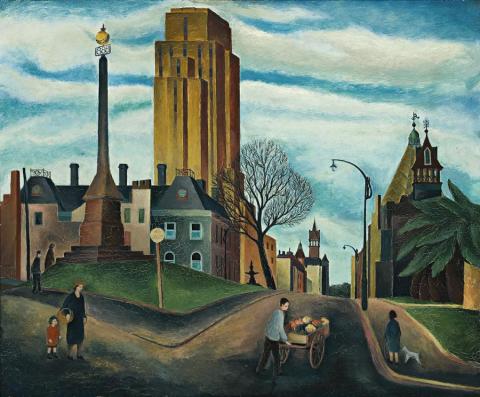THE 8 HOURS MONUMENT, RUSSELL STREET, c.1947
Alan Sumner
oil on composition board
62.5 x 75.5 cm
signed lower right: ALAN SUMNER
Private collection, Melbourne
Dr Mark Awerbuch, Adelaide
Deutscher Fine Art, Melbourne, 1997
The Hicks Family Collection, Melbourne
Alan Sumner, National Gallery of Victoria, 26 October 1993 - 7 February 1994, cat. 17, as ‘The 8 hours monument: Russell Street’
Modern Australian Painting 1920s - 1980s, Deutscher Fine Art, Melbourne, 9 - 20 September 1997, cat. 21
Three 8s Street Scene, 1945, oil on canvas on cardboard, 50.6 x 60.4 cm, signed lower left ‘ALAN SUMNER’, Collection of the National Gallery of Victoria, R. Henderson Donation Fund, 1946
The international movement for an eight-hour working day was long and difficult. Its first success in Melbourne in 1856 was an achievement of considerable importance. Years later, to commemorate this, the Eight Hour Day Memorial funded by public subscription, was erected in 1903 in Spring Street, near Parliament House. In 1923 it was moved to its present, more appropriate position, diagonally opposite the Trades Hall, Carlton, at the corner of Russell and Victoria streets on the city's edge. The monument is surmounted with a golden globe above the symbolic numbers ‘888’ representing the slogan coined by Robert Owen - ‘Eight hours labour, Eight hours recreation, Eight hours rest’.1
It had a special appeal for Alan Sumner, as he painted it twice. The first, Three 8s Street Scene in the collection of the National Gallery of Victoria, dates from 1945. A mid-winter scene, the view is from Russell Street looking north towards the monument. In The 8 Hours Monument, Russell Street the view is south down Russell Street, dominated by the bulk of what was then Russell Street Police Headquarters. The old gaol and Law Courts are to the right, and St Michael's Uniting Church can be seen in the far distance, on the corner of Russell and Collins Streets. The mood is also different. While the same bare-branched tree occupies a central position in both, there is a new feeling of seasonal change in the air, expressed in the brighter and warmer colour scheme. This is emphasised by the foreground figure of the man with his barrow full of bright spring flowers. The stillness, engaging simplification and directness of imagery found in this painting characterise his best works.
Like many artists of his time, Sumner was interested in producing landscapes of both the city and country. As he lived most of his creative life in the inner city suburb of Collingwood, his paintings often drew upon working class themes. Subjects were the everyday - a street scene in Melbourne's Windsor or a rural view of Darebin Creek and its old brick bridge, on the way to Heidelberg. Typical paintings include Cyclists near Geelong, c.1939, in the collection of the Geelong Art Gallery, Washing Day, 1944, Country Railway Station, 1945, and Cabbage Patch, c.1947, in the Ballarat Fine Art Gallery. In 1945 he painted Rose Chapel, an old church at St Helena, near Eltham, where he was married a few years before. In the latter part of the 1940s Sumner extended his weekend painting expeditions to include Upwey and Ferntree Gully. His Lysterfield Landscape, c.1946, was awarded the Art Gallery of Ballarat's George Crouch Memorial Prize in 1948.
1. The Eight Hour Day commemoration was renamed ‘Labour Day’ in 1934
DAVID THOMAS
